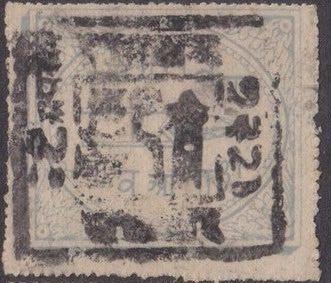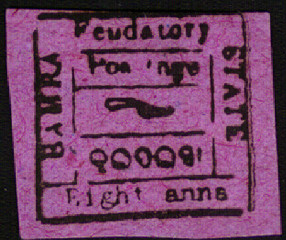


(Could this be bogus issues for Bhor?)
Note: on my website many of the
pictures can not be seen! They are of course present in the cd's;
contact me if you want to purchase them: evert@klaseboer.com.
Many fiscal stamps exist from the indian states as well!
Also many forgeries exist: see the excellent site http://www.princelystates.com/CurrentIssue/ff-04-01a.shtml for more information.
I have not yet been able to identify the following stamps:



(Could this be bogus issues for Bhor?)
Bogus stamps of Jhind:



These bogus stamps were probably issued by a Mr.
Moquette of Dutch East Indies (see Filatelie informatief
September 1983 p 7060-10, in dutch). More values and values in
different colours exist. Moquette also made a bogus issue for Johore. All these stamps were also
sold by the stamp dealer Friedl in Vienna. Moquette also made
several bogus overprints on genuine stamps of Dutch East Indies.
Two of the images were found at http://home.att.net/~rickscott/Unidentified/Unk376.html
and http://home.att.net/~rickscott/Unidentified/Unk377.html.
The Stamp Almanac (Almanach du Timbre-Poste) by J.B.Moens of 1886
shows an image of the red bogus stamp shown above (16 March) with
the following text: "MM Senf frères se décident à
parler et nous disent enfin où le type ci-contre est en usage.
Cela ne leur procure aucune difficulté, vu qu'ils ont été les
seuls à vendre ces timbres." (Translation: The Senf brothers decide to talk and finally tell
us where the stamp shown here is used. This doesn't give them any
problems, since they are the only ones selling these stamps.).
The 1/2 Rupee stamp is shown in the same book on 12 April, while
making fun of the Illustrirtes Briefmarken Journal (issued by the
Senf brothers).
On the other hand, Moens in 'Le Timbre Poste' no 182, page 11
(1878) shows an image of the above stamp (elephant desing) with
the message that Moens obtained this stamp from A.Nieske (also a stamp forger).
1/4 a blue 1/4 a green 1 a brown
The 1/4 a values exist with rouletted perforation and with perforation 12. The 1 a value only exist with rouletted perforation.
Value of the stamps |
|||
vc = very common c = common * = not so common ** = uncommon |
*** = very uncommon R = rare RR = very rare RRR = extremely rare |
||
| Value | Unused | Used | Remarks |
| 1/4 a blue | ** | * | Exists with wide and narrow margins. |
| 1/4 a green | ** | ** | Exists with wide and narrow margins. |
| 1 a brown | ** | * | |
Cancels: I've seen these stamps with circular town cancels, but also with squarish town cancels.



"KATHUMAH ULWAR STATE" and circular cancel with
"POST OFFICE" at the bottom
Forgeries:

First forgery
Imperforate forgeries exist (they are quite blur) of the 1/4 a blue, with the dagger blade slightly too wide (first forgery, see image above). It has thin blue framelines where the rouletting was supposed to be.

Second forgery
Another forgery of the 1/4 a blue has the background pattern behind the ellipse different from the genuine stamps (second forgery, see image above). Also note the fourth Indian character at the bottom and the shading on the dagger.

Yet another pair of forgeries of the blue stamp.


Modern forgery (1980'?) of the 1 a value. Click here for Indian States, modern forgeries, more
examples. It also exitst printed in the wrong colors: yellow
green, dark green or lilac. It is printed in sheets of 12 and is
imperforate. The impression is very bad, the ellipse with pearls
is very badly done.
More information on forgeries of Alwar can be found on: http://princelystates.com
Bahawalpur (situated in the southern part of Punjab) issued stamps from 1945 to 1949. About 60 stamps were issued. Examples:
With red overprint in native text (for official use): green and black (water works), red and black (camels), brown and black (camels), violet and black (deer), olive-green and black (pelicans), brown and black (palace), orange and black (tower). 90,000 sets issued.
With black overprint in native text: brown and black (palace), orange and black (monument), blue and black (water works).
With black overprint in native text and "SERVICE" (also colour changes): red and black (water works), red and black (camels), orange and black (deer). 350,000 sets issued.
1 1/2 a green (inscription "SERVICE" at left hand side). 100,000 stamps issued.
1/2 a red and black
1 1/2 a green and red (500,000 stamps issued).
3 p blue and black (local ruler, small sized stamp), 1/2 a red and black (design as 3 p), 9 p green and black (design as 3 p), 1 a red and black (design as 3 p), 1 1/2 a violet and black (design as 3 p), 2 a red and black (temple), 4 a brown and red (temple, different from 2 a), 6 a blue and black, 8 a lilac and red, 12 a red and green, 1 R orange and green (local ruler), 1 R brown and violet, 2 R red and black (design as 1 R), 2 R red and green (design as 1 R), 5 R blue and black (design as 1 R), 5 R violet and black (design as 1 R), 10 R green and brown (three amirs), 10 R black and red (three amirs).

1 a red and black, overprinted with black local text (for
official use)
Overprinted with red or black local text (for official use): 3 p blue and black, 1 a red and black, 2 a red and black (temple), 4 a brown and red (temple), 1 R orange and black, 2 R red and black, 5 R blue and black, 10 R green and brown.
Inscription 'SERVICE' at the left hand side: 3 p blue and black (ruler, design as postage stamp), 1 1/2 a lilac and black (as 3 p).
1 1/2 a red and black (soldiers)
3 p blue and black (irrigation), 1/2 a brown and black (wheat), 9 p green and black (cotton), 1 a red and black (bull).
9 p green and black, 1 a lilac and black, 1 1/2 a orange and black, 2 1/2 a blue and black.
Overprinted in red native text for official use: 9 p green and black, 1 a lilac and black, 1 1/2 a orange and black, 2 1/2 a blue and black.
I have seen stamps with forged cancels of this issue (both the normal and official stamps).
1/4 a black on yellow 1/2 a black on red 1 a black on blue 2 a black on green 4 a black on yellow 8 a black on red
Value of the stamps |
|||
vc = very common c = common * = not so common ** = uncommon |
*** = very uncommon R = rare RR = very rare RRR = extremely rare |
||
| Value | Unused | Used | Remarks |
| All values | RR | RR | |
| Reprints | c | c | |
Deceptive reprints exists, differing only in the curvature of the bottom right hand side of the fourth Indian character.
Forgeries exist, see: http://www.princelystates.com/CurrentIssue/ff-04-01b.shtml for more information. I know that Fournier offered forgeries of the values 1/4 a to 2 a (4 values), he offers them in his 1914 pricelist for 1 Swiss Franc as second choice forgeries. A picture of such a forgery can also be found in 'The Fournier album of philatelic forgeries' by Ragatz.


Other Fournier forgeries from 'Fournier Albums' (left two images
reduced sizes)

1/4 a black on lilac 1/2 a black on green 1 a black on yellow 4 a black on lilac 8 a black on lilac 1 R black on lilac
There are two varieties of these stamps, with large "P" in "Postage" or with small "p" (I've seen them printed on the same sheet):


Value of the stamps |
|||
vc = very common c = common * = not so common ** = uncommon |
*** = very uncommon R = rare RR = very rare RRR = extremely rare |
||
| Value | Unused | Used | Remarks |
| 1/4 a | *** | *** | Both types |
| 1/2 a | *** | *** | " |
| 1 a | *** | *** | " |
| 2 a | *** | *** | " |
| 4 a | *** | *** | " |
| 8 a | *** | R | " |
| 1 R | R | R | " |

A whole sheet of 1/4 a stamps.
Forgeries exist, see: http://www.princelystates.com/CurrentIssue/ff-04-01b.shtml for more information. By the way, I'm not quite sure that the above stamps are genuine.
The next stamp is a forgery:


This forgery has a space between "Pos" and
"tage". Also the Indian inscription is the same for all
values (I've seen the values 1/4 a, 1 a and 4 a as well). The
first "A" of "BAMRA" seems to be rather
small.
Another forgery:

Forgery


I've been told that these are Fournier forgeries, they have the
wrong native inscription (the one belonging to the 1/4 a value!).

Some very badly printed forgeries.
A cut from a postal stationery:

From 1921 on Barwani issued its own stamps.

1/4 a green 1/4 a blue 1/4 a black 1/4 a lilac 1/2 a blue 1/2 a green Different design 1 a red 1 a brown 2 a lilac 2 a red Yet another design 4 a brown 4 a green

1/4 a 1/2 a green 1 a brown 2 a lilac 4 a olive
1 a brown
3 p brown 6 p red 9 p violet 1 a blue 2 a green
4 a orange 6 a yellow 8 a green 12 a blue 1 R violet